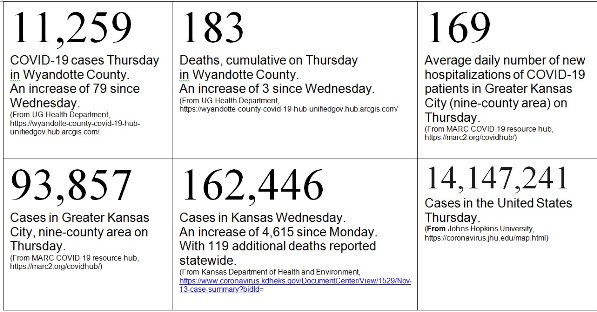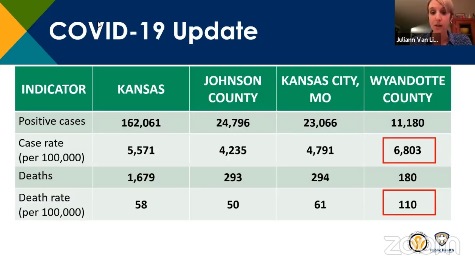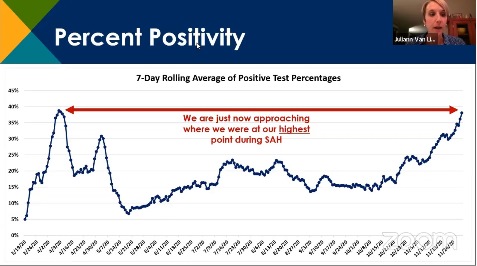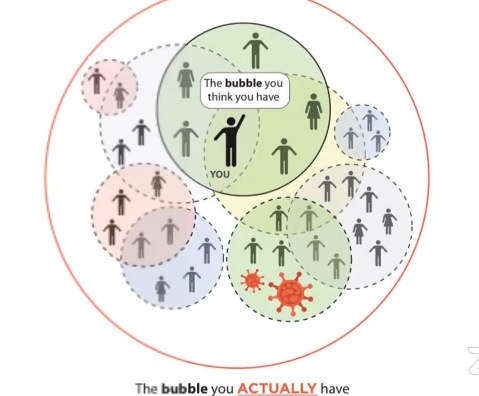

The Unified Government Commission on Thursday night extended the local health emergency for the COVID-19 pandemic through March 15 in Wyandotte County.
The vote was 8-0 at the 7 p.m. Dec. 3 remote Zoom meeting to extend the health emergency. The action was taken after a report from the UG Health Department.
Friday will be the two-week mark for the new health orders on 10 p.m. closing times and gathering limits of 10, according to the Health Department. The county also has had a mask mandate and social distancing order for several months.
“We’re in quite a surge right now,” Dr. Erin Corriveau, deputy health officer, said at the UG meeting. “At the Health Department, we are beginning to wonder that even if we’re complying with the current orders if that is actually going to be enough to decrease the spread of this virus and help save that hospital capacity that we’re thinking we’re going to be needing, especially after the Thanksgiving holiday.”

Percent positivity rate rises to 38 percent
Juliann Van Liew, Health Department director, said Wyandotte County’s seven-day rolling average is about 75 new cases a day. The percent positivity is very high at 38 percent, she said.
Van Liew cautioned against thinking that a dropoff in case numbers over the Thanksgiving holiday would last, as Health Department testing was closed Thursday through Sunday, which may have affected the number of new cases reported then. She didn’t think the lower numbers over the holiday reflected the reality of COVID-19 spreading, and she expected a rebound to happen quickly on the case numbers.
The percent positivity rate is approach that of April in Wyandotte County, she said. But in April they were testing only about 100 a day then, as compared to 650 to 700 people a day now, Van Liew said. There are many more cases from the 38 percent positivity rate now than there were then.
They continue to see growth in the younger age group for case numbers, she said. The 20-29 age group has the most cases currently. They’re about three times higher than the 60-69 age group. Ages 30 to 49 also are high.
Enforcement efforts
Dr. Allen Greiner, chief medical officer for the Health Department, said the Health Department has hired two retired law enforcement officers to be safety inspectors. Since Nov. 9, they have been following up on reports on the 311 phone line and on complaints to the police and sheriff’s office, he said.
The inspectors have made 103 visits to places since November, averaging four to five per day, he said. There were 29 visits to restaurants, 15 to gas stations and 12 visits to grocery stores and large retail stores, he said.
Dr. Greiner said the current focus is on education, with no citations written. They are educating businesses about mask use, social distancing and the rules applying to capacity and closing times.
When they make a first visit, the safety inspectors provide education about the use of masks and talk about what’s going on. They’ve made 95 first visits, six second visits and one third visit, he said.
“So far, we feel like people are really complying, the education is well received, and the businesses as well as individuals in those environments are making changes,” Dr. Greiner said.
The inspections found that 54.9 percent of the businesses did not have good employee screening, such as temperatures taken and questions on arrival, he said.
Employee mask compliance has been moderate, with 28 percent of the businesses having at least one employee with no mask on.
Customer mask compliance also is moderate, with 25 percent of the businesses reporting one customer without a mask, he said.
Social distancing is good, and the inspectors are taking signs and floor stickers out to the businesses, he said.
Falling behind on contact tracing
With the major spike in cases since the beginning of November, and hundreds of cases each day, they’ve fallen behind on contact tracing, he said. They now have 30 full-time contact tracers, 20 part-time student volunteers and seven volunteer UG employees doing contact tracing, he said.
“We’re back to where we’re 600 to 700 cases behind now,” he said.
Currently, they are prioritizing the new cases and not worry as much about the cases that are six to nine days old. Also, they are focusing on individuals 30 and younger, because they are more likely to be active in the community, spreading the virus more.
They may ask the state again for some assistance, or look for other strategies, he said. It is a nationwide problem currently, with the increase in cases, he said.
They are encouraging individuals to do their own contact tracing as well, he added.
Hospital capacity is a concern
Dr. Corriveau said there were some pretty significant challenges in Wyandotte County on hospital capacity.
Currently, 20 percent of all patients at KU Health System hospital in Kansas City, Kansas, have COVID-19, she said.
Patient to nurse ratios are starting to change, from a 2-to-1 ratio in the ICU to a 3-to-1 ratio, she said.
That type of ratio change has unfortunate consequences, potentially, she said.
Also, elective surgeries have slowed or halted, and patients without COVID-19 are being moved to the Indian Creek hospital location to expand space in the Kansas City, Kansas, hospital, she said. The hospital also is converting another ward to serve ICU patients, she said.
The ICU ethics team is discussing rationing of care, should it become necessary, she said.
They are also discussing shifting the staff as needed, such as shifting emergency room doctors to work in the ICU, she said.
They are continuing to have difficulty with transfers and rationing of care now occurring in rural Kansas, she said. It is happening in the entire region now, she said.
Dr. Corriveau said Thursday morning there was an article from Great Britain that praised Wyandotte County and its mask efforts from June to October.
“I want to say thank you to the community for wearing a mask,” she said.
Counties were assigned a mask-wearing score from 0 to 5, with Wyandotte County at 3.4, relatively high compared to the national average of 2.9, she said.
Looking at the months of June to October, Wyandotte County residents wore their masks, and the community was able to save as many as 150 lives, according to the article.

Limit ‘bubble’ to immediate household members
Dr. Corriveau asked residents to limit their “bubble” – those they come into contact with – to immediate members of their household.
“We’re asking all of you, please, limit your social bubble now, to only those in your immediate household,” Dr. Corriveau said.
The “bubble” you think you have may actually be much larger, Dr. Corriveau said. People think they have a small bubble, but those around them may have large bubbles, and all of a sudden they are interacting with many others.
Dr. Corriveau said they intend to keep children in school for as long as possible. Driving down the infection rate in the community will keep them in school, she said.
Also, the Health Department is trying to emphasize mask-wearing, she said.
She said it is a really difficult time currently for residents, and schools and businesses will have to keep going until there is some kind of relief. They are trying to support businesses and families by advocating for economic relief, she said.
They also are staying in touch with other leaders in the metropolitan area, coordinating efforts to stop COVID-19, she said.
Three deaths, 79 more cases reported
On Thursday, Wyandotte County reported an additional 79 COVID-19 cases, for a cumulative total of 11,259, according to the Unified Government COVID-19 webpage. There were an additional three deaths reported, for a cumulative total of 183.
The Mid-America Regional Council’s Kansas City Region COVID-19 Resource Hub reported a cumulative total of 93,857 COVID-19 cases on Thursday in the nine-county area. There were a cumulative 1,126 deaths reported. The average daily new hospitalization rate was 169 in the nine-county area, a decrease from Wednesday.
The Johns Hopkins COVID-19 Dashboard reported a total of 14,147,241 COVID-19 cases in the United States on Thursday.
The University of Kansas Health System reported a decrease in the number of active COVID-19 patients at the hospital on Thursday morning. There were 89 active COVID-19 patients, down from 100 on Wednesday, with 46 in the ICU, a decrease of two since Wednesday, and 28 patients on ventilators in the ICU, a decrease of one from Wednesday, according to Dr. Dana Hawkinson, medical director of infection prevention and control. There were 68 other patients in the hospital in the recovery phase, an increase of nine since Wednesday. The total number of COVID-19 patients was 157, a decrease from 159 on Wednesday.
HaysMed in Hays, Kansas, reported 37 COVID-19 inpatients, an increase from 32 on Wednesday, with 25 in the active phase and 12 in the recovery phase.
While it will still be some time before they know exactly how the case numbers were affected by Thanksgiving gatherings, the doctors think the current hospital numbers are reflective of the time before Thanksgiving. In another week they may see results of any infections that occurred during the Thanksgiving holiday.
At the KU doctors’ news conference on Thursday morning, the details about monoclonal antibodies were explained. The antibodies now can be given to outpatients who qualify. The patients who receive them are generally older than 65 and have some comorbidities, according to the doctors.
The infusion process will be available to outpatients within the first seven days of infection, according to the doctors. So far, all those who receive monoclonal antibodies at KU Health System have a doctor who practices at the health system.
Several other hospitals in Greater Kansas City also were expected to have monoclonal antibodies available for patients.
During the news conference, Dr. Hawkinson said the new CDC shortened quarantine guidelines were “potentially dangerous.” He was in favor of the full 14-day quarantine, based on the evidence. He urged people to continue wearing their masks and socially distance.
Free COVID-19 testing available Friday
Free COVID-19 testing will be available from 10 a.m. to 1 p.m. Friday, Dec. 4, at South Park Recreation Center, 246 Shadyside Ave., Bonner Springs, Kansas.
The pop-up test is through Vibrant Health and the Wyandotte County Health Equity Task Force.
The Unified Government Health Department has moved its COVID-19 testing from the 6th and Ann location to the former Kmart at 78th and State Avenue in Kansas City, Kansas. The hours are 9 a.m. to 3 p.m. Monday through Friday.
Tests are free for those who live or work in Wyandotte County. The tests are now saliva COVID-19 tests.
The tests now are open to asymptomatic people as well as those who have symptoms or have been exposed to COVID-19. Check with the UG Health Department’s Facebook page to see if there have been any changes in the schedule. Bring something that shows that you live or work in Wyandotte County, such as a utility bill.
For more information about the testing site at the former Kmart location, visit https://alpha.wycokck.org/files/assets/public/health/documents/covid/10092020_newtestingsitewyco.pdf.
The UG Health Department report is online at https://www.youtube.com/watch?v=u-zOYt3eNj4.
The KU doctors’ morning news conference is online at https://www.facebook.com/kuhospital/videos/420961332270344.
For more information, visit https://wyandotte-county-covid-19-hub-unifiedgov.hub.arcgis.com/pages/what-to-do-if-you-think-you-have-covid-19.
The new Wyandotte County health order with a limit of 10 persons to a gathering, and a closing time of 10 p.m. for restaurants and bars, with other new restrictions, is at https://alpha.wycokck.org/files/assets/public/health/documents/covid/11162020localhealthorderexecuted.pdf.
The UG COVID-19 webpage is at https://alpha.wycokck.org/Coronavirus-COVID-19-Information.
The KDHE’s COVID-19 webpage is at https://www.coronavirus.kdheks.gov/.
The KC Region COVID-19 Hub dashboard is at https://marc2.org/covidhub/.
The Wyandotte County page on the Johns Hopkins COVID-19 website is at https://bao.arcgis.com/covid-19/jhu/county/20209.html.
The CDC’s COVID-19 webpage is at https://www.cdc.gov/coronavirus/2019-nCoV/index.html.
